TAGGED AS: Amazon, Fantasy, Prime Video, streaming, television, TV
Harfoots do not drink ale. The halflings featured in Prime Video’s The Lord of the Rings: The Rings of Power are a migratory group thousands of years from settling in the Shire and cultivating the right crops for beer. But as Dylan Smith, who plays Largo Brandyfoot, told Rotten Tomatoes when we spoke to him at Comic-Con International: San Diego in July, the group still have fermented beverage stowed in their carts.
“They drink a berry juice,” he explained. “Depending on how long it’s been sat in the barrel, a blackberry wine would be our choice of celebratory cocktail.”
That level of detail is the hallmark of author J.R.R. Tolkien’s world — known as Arda to the most devoted readers or, more generally, as Middle-earth. From his time in service during World War I to his death on September 2, 1973, Tolkien established genealogies, histories, cultures, and languages spanning the creation of his universe (aka Eä) to the early parts of Middle-earth’s Fourth Age, a time when Man took complete control of the world and its more fantastical aspects slipped away into myth and legend.
Ironically, Rings of Power concerns itself with the era Tolkien sketched in the least detail: the Second Age. It is a time before most of the old, ruined kingdoms Frodo and the Fellowship wander through in The Lord of Rings were founded, but the legacy of the First Age’s great wars still dominates the emerging cultures of a land experiencing a wary peace. Of course, by saying it is the least developed of Tolkien’s time periods still means there are plenty of familiar characters charting the wilds and names connected to the legends the Fellowship tell and hear millennia later. Detail, after all, is a Tolkien specialty and it still represents a lot material. That gives Rings of Power a unique opportunity to be both familiar and refreshingly new all at once.
One example: the Harfoots themselves. Tolkien never specified when or how Hobbits came into existence, but offered that they emerged from three halflings tribes who wandered up and down the River Anduin (and nearby tributaries) for many generations before migrating west to the Shire. Rings of Power uses this historical imprecision to imagine a group of migrant Harfoots near the beginning of the Second Age. As Smith explained, they follow a precise, but lengthy circular path to maintain their existence.
“We have spots, which we plant so we can restore our goods,” he said. “They are our lifeline because we’re pretty meager.”
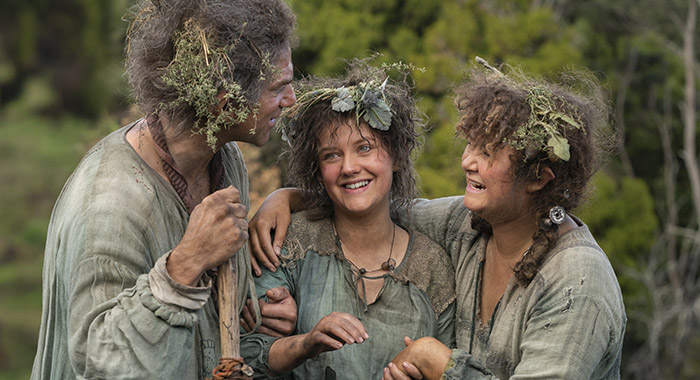
(Photo by Ben Rothstein/Prime Video)
Their story in the series is anchored by Largo’s daughter, Elanor (Markella Kavenagh) — Nori for short – who’s thirst for adventure will be recognizable to fans of The Hobbit‘s Bilbo Baggins and his nephew, Frodo of the Nine Fingers. Although, Kavenagh believes that call to adventure is rooted in a Halfling’s hyper-evolved sense of fear.
“It can either instill this sense of needing to avoid moving out and stepping out of your comfort zone, or it can instill this yearning to find a way out of it,” she explained when we spoke to her in August. “I think that’s what Nori has, for sure, she thinks that to actually confront the problems you have to take risks … She leads with the idea that a fear of risk can be greater than the risk itself sometimes, and that you do have to take it.”
Nevertheless, the opportunity to spend more time in a Halfling community affords the series the chance to see why they are so close-knit and resistant to dealing with the “Big Folk.”
As Sara Zwangobani, who plays Nori’s mother Marigold, put it, “‘Nobody goes off trail and nobody walks alone’ is their motto and their mantra. That they all look out for each other and that they stick together, and that they protect each other from the outside world.”
That sense of protectiveness and community definitely comes off as warm and inviting. It may be something suggested of the Shire in The Hobbit and The Lord of the Rings — certainly in their film versions — but appears very much as a new element in Rings of Power‘s Second Age.
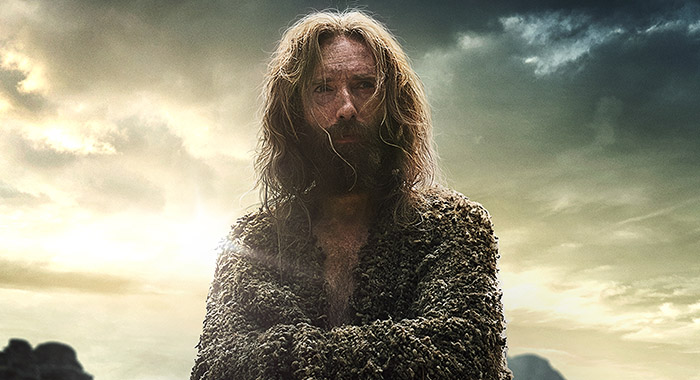
(Photo by Prime Video)
Meanwhile, Nori’s adventure speaks to something genuinely new in Middle-earth: a mystery with no apparent or easily-won answer from Tolkien lore. As the series begins, she encounters a Stranger (Daniel Weyman) who does not seem to fit into any of the usual categories in Middle-earth, but as viewers will soon see, he demonstrates some abilities which may lead fans to suspect he is an old and familiar character.
“I think what’s clear is that we want to allow the audience to experience this character,” Weyman said. “We don’t want to know what his intentions are at the very beginning. That’s going to be part of the joy of watching this character. It’s already giving us lots of things, people are already discussing online; having differing opinions, arguing rumors, supposition. Of course, it is too early to guess just who he might be. For the moment, he is just a confused person Nori feels compelled to help.”
But the mystery of the Stranger may speak to one of the other questions the series poses in its early hours: Where is the Lord of the Rings himself? In one of the show’s most familiar aspects, the worry about Sauron is the chief concern of Galadriel (Morfydd Clark). And although she is one of the most established characters across the three major ages of Middle-earth, Rings of Power still brings a fresh perspective to the character as her quest for Sauron becomes an all-encompassing and personal mission inspired, at least in part, by the fact she is still alive.
“She’s lost so many people she loves [in the First Age wars],” Clark said. “And, also, just for an elf to lose someone [when] they’re meant to be there forever [is painful.]”
In the First Age, Sauron was the chief lieutenant of the previous Dark Lord, and though defeated, his whereabouts remain unknown to the elves of Middle-earth. That uncertainty, even before the series begins, is too much for Galadriel to bear. “[The elves] can’t escape their past, they were there for it. So that was really interesting to explore,” Clark said.
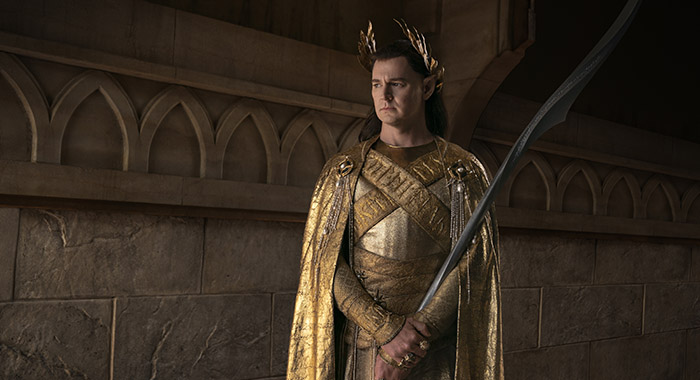
(Photo by Ben Rothstein/Prime Video)
Her need for answers does not appear to be shared by the other elves of the era. At this time, the various elvish communities are ruled by High King Gil-Galad, a name famously referenced in The Lord of the Rings (the novel, anyway), but a character rarely presented in the present-tense action of a Tolkien story. Actor Benjamin Walker breathes life into him and said one of his key features is that he “never rests.” As high king — a role audiences really haven’t seen in previous Middle-earth movies — there is always a concern in maintaining the peace and warding against the possible return of evil.
“These are the elves that chose to stay and protect Middle-earth,” Walker explained. “I think he takes that infinitely seriously.”
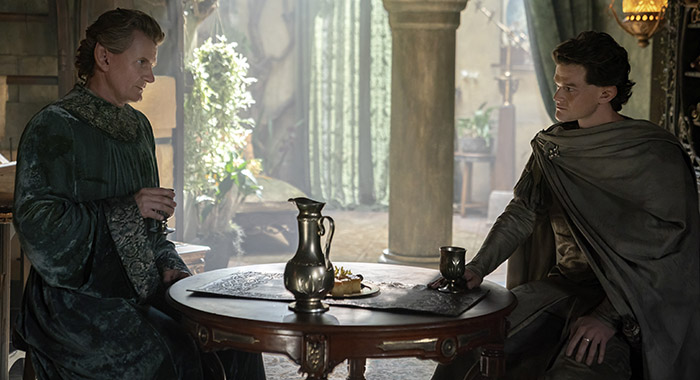
(Photo by Ben Rothstein/Prime Video)
To that end, Gil-Galad assigns Elrond (Robert Aramayo, pictured above right) to assist the great elf craftsman Celebrimbor (Charles Edwards, pictured above left) in new project southeast of the elvish capital. The former is one of the most famous elves in Tolkien’s work (portrayed by Hugo Weaving in the Peter Jackson Middle-earth movies), while the latter is one of the most infamous as he crafted almost all of the Rings of Power. But at the series begins, neither are aware of what songs and stories will tell of their accomplishments and, for the moment, are just working toward Gil-Galad’s command. Or course, as Edwards explained, Celebrimbor has a personal goal within the work to be done.
“He wants to do good and to be of benefit,” he said. “[But] like many creative people, he also wants a reaction, and congratulation, and adulation.”
That personal dimension will, in time, lead to a great strife which Edwards mentioned is part of Tolkien’s own “wariness” about the elves passion for craft and creation.

(Photo by Ben Rothstein/Prime Video)
And as trailers and other clips have revealed, Celebrimbor’s goal will lead Elrond to a diplomatic mission within the halls of Khazad-Dum. Not yet known as the Mines of Moria, the great dwarven kingdom is in ascendancy during this era and is represented by two wonderful dwarf characters: Prince Durin IV (Owain Arthur) and his wife Disa (Sophia Nomvete).
“There is a huge heart to the dwarves,” Arthur said of Durin’s folk, who often defaulted to comedic relief in previous Middle-earth projects. Some of that humor remains, but Arthur said their big hearts will be more fully delved as the series continues. “If they love, they love with passion and fire. If they’re angry or upset, then there’s nothing that will get in their way. As an actor, that was great to explore those extremes every time. You are going to see layers to them and the inner battle that’s going to occur as the series goes on,” he said.
One example of that is Disa herself, who introduces a warm, maternal side to the Dwarves. Although, as Nomvete mentioned, those are just the first dimensions of the character viewers will see when they meet her.
“The breakdown for this character, even from the audition, was ‘warm, strong, maternal, powerful, formidable,'” she said. “There could have been different ways to go, but we chose to have moments of every single one of those adjectives and just make her into this ball of loveliness.”
Also, prepare to have the Khazad-Dum theme, composed by Bear McCreary, stuck in your head after you watch the two-part debut. Like the dwarves themselves, it is unexpected, powerful, and memorable.
The sense of progress and peace in the elvish and dwarven parts of Middle-earth is not necessarily shared in the Southlands. The men who inhabited the region allied with Sauron and his master, Morgoth, during the First Age, and are closely watched by the elves. Or, from the manish point of view, the elves are occupying the land in the name of “protection.” One such occupied space is the village of Tirharad, populated by men living a hardscrabble existence as a group of Silvan Elves (Legolas’ people) keep an eye out on the area from a nearby tower.
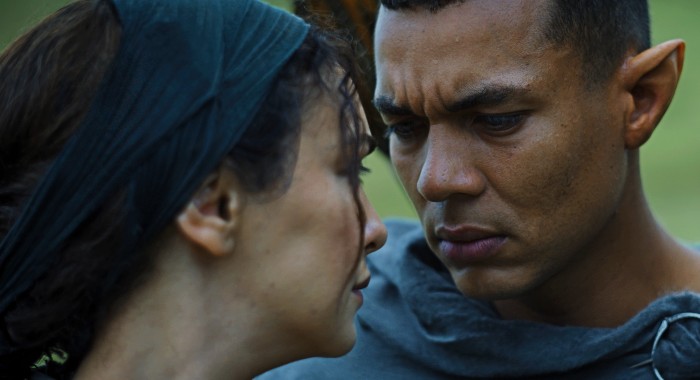
(Photo by Prime Video)
Although the tension between elves and humans is noted throughout Tolkien’s work, it comes into sharp contrast via its depiction in the series and the forbidden love affair between Tirharad’s healer, Bronwyn (Nazanin Boniadi), and Silvan Elf Arondir (Ismael Cruz Cordova). Although such unions between elves and humans are not unheard of (indeed, some of Tolkien’s best stories revolve around the concept), it is discouraged as it always leads to tragedy. At the same time, viewers will quickly see the relationship is laced with a sweetness both familiar and new.
“[Bronwyn is] the poor man’s human, and in a similar way, I think Ismail’s character, Arondir, is the poor elf’s elf,” Boniadi said of the two characters. “So, I think we have that in common in the sense of not being in the upper echelons of our own kind.”
Those commonalities are complicated, however, by their communities’ respective disdain for one another, and even Bronwyn’s wish to redeem her people.
“She wants to free the Southlanders from the shackles of their history,” Boniadi said. “But she’s also shunned within her own people because she’s in love with an elf and because she’s a single mother to a rebellious teenage son.”
For his part, Cordova added part of what makes Arondir sympathetic is his willingness to believe the men of the south can change.
“I don’t know what came first – maybe it’s the love for Bronwyn that makes him want things to be different or that he does believe [the Southlanders can change] and then falls in love with her. But I think he does have a deep admiration for the race of men,” he said.
Finally, in the farthest west where men can travel, is the island nation of Númenór. It is, perhaps, the location Tolkien fans have most longed to see as it is well known and yet remote. Created by the Great Powers of Arda as a reward for the tribes of Men who fought against Morgoth in the First Age, it is home to a long-lived race of mariners and seafarers.
Although, as the series begins, it faces a crisis of leadership. Its king nears the end of his long life and his daughter, Míriel (Cynthia Addai-Robinson), assumes the day-to-day duties of leadership and the title of Queen Regent.
“I think what’s interesting to navigate was just having that sort of internal sense of something is shifting, something is about to happen, and she grapples with that on her own,” Addai-Robbison said of her character’s predicament.
Her ascension also reignites a tension between two political groups either aligned or opposed to their vows from the First Age.
“There are those who want to follow the elves, the old ways — The Faithful,” explained Leon Wadham, who plays a Númenórean royal named Kemen, “and [there are] The King’s Men, the people who are looking to forge a path out of the shadow of the elves to create their own legacy independently. I think at present, these two factions are living semi-harmoniously. Things are becoming more and more delicate, I’d say.”
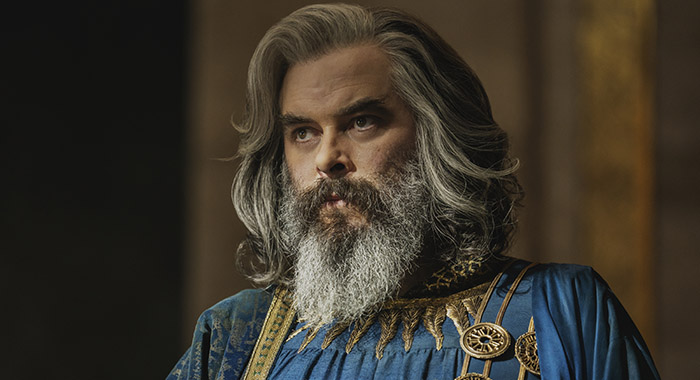
(Photo by Matt Grace/Prime Video)
Isolated to some extent, Míriel’s decision about that conflict will put Númenór on its path in the season (and seasons) to come. But she has one person she can lean on for counsel: her cousin Pharazôn (Trystan Gravelle). That name also looms large in the history of Middle-earth, but when viewers meet him, he is a chancellor looking out for both his cousin and their nation.
“There’s a lot of, dare I say, new responsibilities and new challenges for Pharazôn. It’s something that he relishes firmly for his people … but I think that would put years on a man,” Gravelle said.
The conflict between Faithful and King’s Men also weighs heavily on the heart of Elendil (Lloyd Owen), a tall mariner who will eventually become king of the Middle-earth realm known as Arnor. But according to Owen, he is “on the fence of those two sets of convictions, feelings, and loyalty” as the series begins.
“There’s a great division between head and heart for him too,” he added. Although his heart (and family history) place him squarely on the side of elves, Owen said his pragmatic sensibilities could see him leaning to the King’s Men for the safety of his children, themselves also at crossroads in their lives and beliefs.
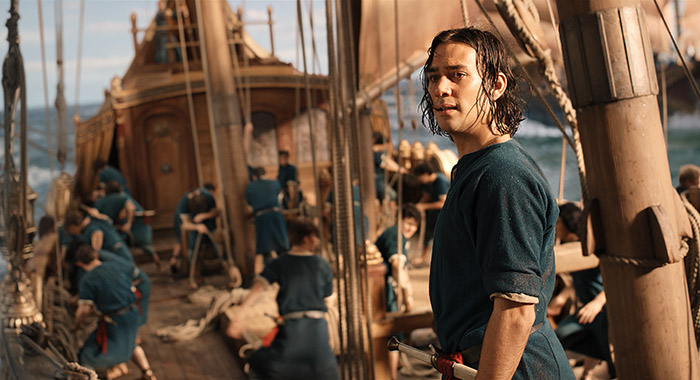
(Photo by Prime Video)
The characters of Númenór, in many ways, represent that balance between the series’ aim to tell the familiar story Tolkien sketched out while bringing a new and deeper sense of character and immediacy to their actions. One challenge many of the actors agreed about in this regard is the knowledge of their characters’ future actions.
“I tend to just be present, and just explore what’s happening around him at the minute,” said Maxim Baldry, who plays Elendil’s son Isildur — a legend in his own right. “You meet Isildur at a point where he is on the cusp of adulthood, and yearning for something that’s deeper … I didn’t want to think too much about the ending, because that’s not where he is right now.”
Clark added, “It was really interesting to just be playing them, knowing who they would become, but that these characters don’t know, and that we had to keep reminding ourselves that these characters don’t know where they will end up.”
And although The Rings of Power invites fans of Middle-earth to return to a place that is familiar, viewing it from the standpoint of its newer elements and story may be the best way to appreciate its world-establishing debut. Although fans and viewers may know where the story goes, the previously unknown journey should be a thrill to those fresh to the Second Age and those who recognize so much of the history about to unfold.
![]() 84%
The Lord of the Rings: The Rings of Power: Season 1
(2022)
premieres Sep 2, 2022 on Prime Video.
84%
The Lord of the Rings: The Rings of Power: Season 1
(2022)
premieres Sep 2, 2022 on Prime Video.